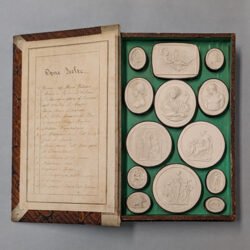The stretcher keys are the thin, triangular wooden wedges that are hammered into the slots located at the inner corners of the stretchers, in order to tighten the canvas by expanding or opening the stretcher.
As far as we know, stretcher keys are first mentioned in the specialized literature by Antoine-Joseph Pernety in his "Dictionnaire portatif de peinture, sculpture et gravure" published in 1757:
"Recently, a way has been invented of making stretchers known as key frames; they are preferable in all to the old frames because by means of the keys the canvas is stretched more strongly also in case of drought when the fabric gets relaxed. These keys are placed in all corners of the assembly & at the ends of each cross bar."
A few years later, this kind of stretcher, together with a regular strainer is illustrated in the 1771 edition of Diderot & d'Alembert ´s dictionary. (Fig. 1)

Fig. 1 - Regular Stretcher (strainer) and Keys Stretcher illustrated in 1771 edition of Diderot Dicctionary
How do the stretcher keys work? Depending on the stretcher they tighten the canvas in a different manner. Single key stretchers, have a tendency to lose the straight angle on the corners, therefore, as a general rule, double key stretcher are preferable. Additionally, it is advisable to hammer the wedges by pairs so that the stretcher opens evenly.
Fig. 2 shows the direction in which a stretcher expands when the keys are hammered.
But, do we position the keys properly? Most of the times, when a painting arrives to our studio, the keys, also sometimes called wedges, are lost or, if they are in place, they are not the way they are supposed to be.
Figs. 3 and 5 illustrate the most frequent way they are positioned, but this is not the proper way. If placed this way, the grain of the wood offers a certain resistance to get into its slot and can result in the key split open in the direction of the grain. However, in Figs. 4 and 6, The grain of the wood wedge is positioned so as to favor the sliding of the key into the slot and the risk of the wedge splitting open diminishes substantially.
All in all, the little wooden wedges or keys have a particular purpose, to stretch out the canvas of the paintings. To do so, they should be placed into their slot and hammered down. If properly positioned they will last longer and hold the canvas tension better, but be wary, if not used properly they can cause problems to the artwork as well. Excessive tightening of the canvas can cause tension cracks, especially in the corners and around the edges of the artwork.
Bibliography:
"Dictionnaire portatif de peinture, sculpture et gravure", by Antoine-Joseph Pernety (Reproduction en fac-similé) Geneve 1972 Web 22 Nov. 2017 http://gallica.bnf.fr/ark:/12148/bpt6k257115.pdf
"Oil, miniature and encaustic painting." The Encyclopedia of Diderot & d'Alembert Collaborative Translation Project. Ann Arbor: Michigan Publishing, University of Michigan Library, 2010. Web. [fill in today's date in the form 18 Apr. 2009 and remove square brackets]. <http://hdl.handle.net/2027/spo.did2222.0001.589>. Trans. of "Peintures en huile, en miniature et encaustique," Encyclopédie ou Dictionnaire raisonné des sciences, des arts et des métiers, vol. 8 (plates). Paris, 1771.











